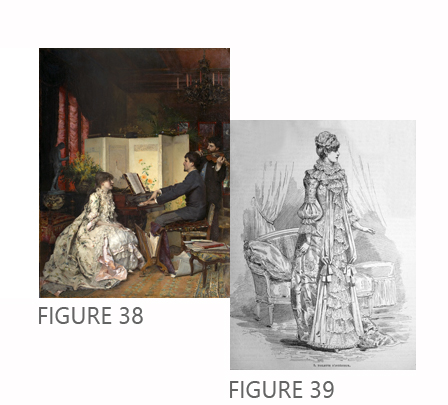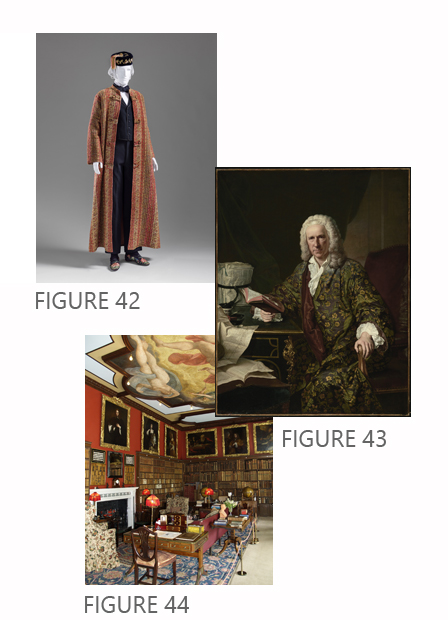Dress to Impress
Clothing has the unique ability to communicate information about its wearer. Marks of status are woven in the language of dress. A hostess, for instance, may not be confused for her maid even though they both don aprons (Figures 35 & Figure 36). Such garments support women’s personal and social identities in a variety of ways. These aprons speak about the wearer’s different functions within the household.1 The gaze of others and how we want to be perceived play an integral part in what we choose to wear in and out of the home.
Social events can transform private residences into public spaces and, in these circumstances, garments meant to be worn at home must rise to the occasion. Victorian women, when inviting guests over for tea, could wear special tea gowns (Figure 38) to express their artful sensibilities, convey their place in the world, and expand their network.2 This type of formal undress may have the fit, bustles, trimmings, embellishments, and luxurious textiles of both day and evening wear.3 Despite the corseted silhouette (Figure 39), many had draped and flowing panels that gave the impression of looseness seen in lingerie.4 The use of light-colored fabrics and lace also could suggest a boudoir aesthetic (Figures 40 & Figure 41).5 Men similarly had liminal garments that straddled private and public such as the banyan, a men’s robe or dressing gown (Figure 42). This loose coat had a long tradition of using exotic and extravagant fabrics (Figure 43). It was a favorite of artists, intellectuals, and men of standing who received guests in their libraries (Figure 44). It was the quintessential garment worn to impress upon others the wearer’s “place in the professional and social hierarchy of the period.”6 Banyans signified intellect and wealth and, like tea gowns, were an appropriate place for whimsical and exotic textiles.[7] They possessed a dual but seemingly contradictory purpose as they were designed for the domestic sphere, while simultaneously engaging with public and external perceptions of status. The home is capable of being a stage for great performances.
Dress can communicate, elevate, and affirm one’s social status. When you wear clothes, is it for your comfort or to impress others? With the COVID-19 lockdown, when we are working from home, how important is fashion? During these liminal times, what does your dress behaviour communicate as you interact virtually with the world from your home?
1 Jeanie M. F. Kirkpatrick, “Dating 50 years of apron 1894-1944” (master’s thesis, Iowa State University, 2015), 15. https://lib.dr.iastate.edu/cgi/viewcontent.cgi?article=1050&context=rcc.
2 Anne Bissonnette, “Victorian Tea Gowns: A Case of High Fashion Experimentation,” Dress 44, no. 1 (April 2018): 4, 5, 6, 7, 19, 23, 25. https://doi.org/10.1080/03612112.2018.1435347.
3 Ibid., 10.
4 Ibid., 19.
5 Ibid., 16, 17, 19.
6 Patricia A. Cunningham, “Eighteenth Century Nightgowns: The Gentleman’s Robe in Art and Fashion,” Dress 10, no. 1 (1984): 7. https://doi.org/10.1179/036121184803657672.
7 Ibid., 7.
Curators
Anne Bissonnette, PhD, Bronwyn Bates, Rhonda Buie, Emma Carr, Juli Grombacher, Frances Heaton, Danielle Klatchuk, Evelyn Leung, Diana Leyva Luciano, Ariane Mendoza, Thomas Osterling, Nicole Morozewich, Emma Ross, and Chloe Schell.







